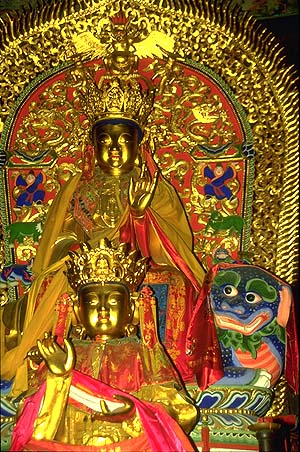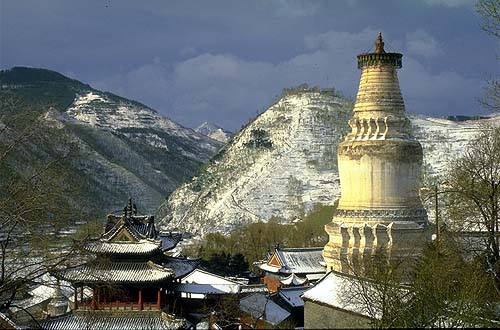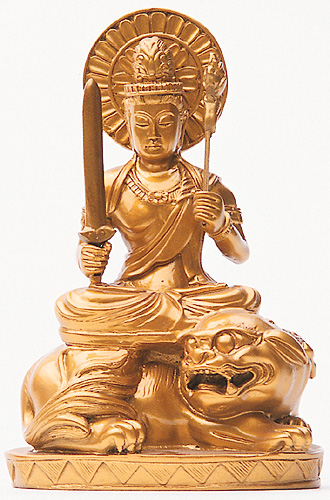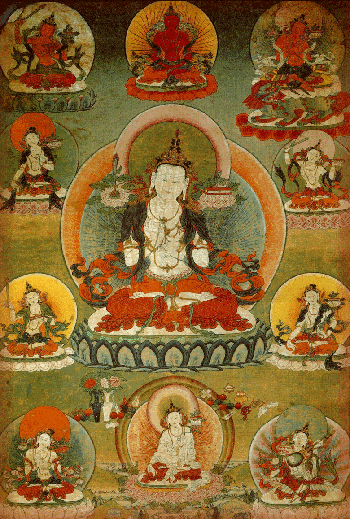Manjushri

Manjushri (or manjusri) is the embodiement of all the Buddha' wisdom. The word manju means “charming, beautiful, pleasing” and Shri means “glory, brilliance”. The Bodhisattva is regarded as the crown prince of Buddhist teachings, or the one who can best explain the Buddhist wisdom, that is able to extinguish afflictions and bring about enlightenment. Manjushri has this title because eons ago, he was the instructor for seven different buddhas, the last being Sakyamuni Buddha. Manjushri is often depicted with his right hand holding a double-edged flaming sword and his left hand holding a lotus flower on which rests the Prajnaparamita (Great Wisdom) Sutra. He is often seen riding a lion. The Prajnaparamita Sutra on the lotus flower symbolizes wisdom as pure as lotus. The sword represents the sharpness of wisdom that to cut through illusion. The lion is called the king of a hundred animals, and this symbolizes the stern majesty of wisdom. In China he is also portrayed as a child with five topknots. This represents the profound fact of wisdom is as truth, non-dual, purity and innocence as a child mind. When one’s mind is in such a state, one can reflect the truth of everything. The five topknots are the five divisions of the buddha’s wisdom: the wisdom of pure consciousness, the wisdom to reflect all things, the wisdom to regard all things equally and universally, the wisdom of profound insight, and the wisdom to seek the greatest good for oneself and others. It is said that Manjushri came from the land of Ratnaketu Buddha in the east. His strength is on the Buddhist doctrines of non-distinction and non-retraction to attain nirvana. Manjushri was known for his unconventionally straightforward style of teaching. Unlike other Buddha and Bodhisattva’s gradual method progressing from elementary to more complex doctrines, he would jump directly to the top, the meaning of the supreme truth, ultimate nirvana.
In China, Manjushri is known as Wen-Shu-Shi-Li.
Two articles from Western Buddhist Review has more information about this Bodhisattva: http://www.westernbuddhistreview.com/vol2/manjusri_parts_1_and_2.html |
 The sacred site of Manjushri is Wu-Tai Mountain in
the province of Shan-Xhi in eastern China. As described in a sutra,
Sakyamuni predicted that after he
enter nirvana, Manjushri would reside on a mountain named Wu-Tai in a east
country named "Great China," where he would teach the Buddhist
dharma. Chinese, Tibetan, Korean, and Japanese Buddhist people hence regard
Wu-Tai Mountain as a sacred place for worshipping Manjushri. Many temples
dedicated to this bodhisattva have been built there.
The sacred site of Manjushri is Wu-Tai Mountain in
the province of Shan-Xhi in eastern China. As described in a sutra,
Sakyamuni predicted that after he
enter nirvana, Manjushri would reside on a mountain named Wu-Tai in a east
country named "Great China," where he would teach the Buddhist
dharma. Chinese, Tibetan, Korean, and Japanese Buddhist people hence regard
Wu-Tai Mountain as a sacred place for worshipping Manjushri. Many temples
dedicated to this bodhisattva have been built there.
